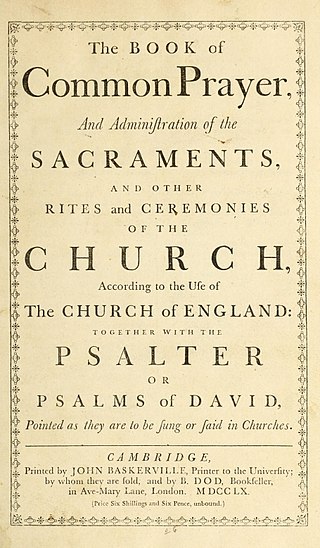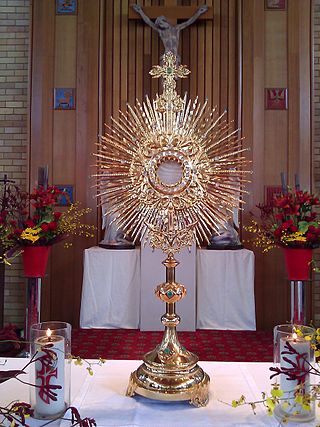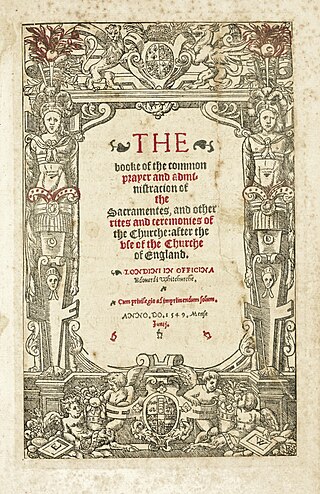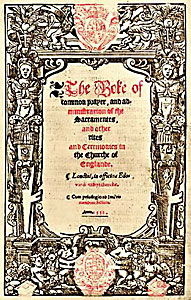Related Research Articles

The Book of Common Prayer (BCP) is the name given to a number of related prayer books used in the Anglican Communion and by other Christian churches historically related to Anglicanism. The first prayer book, published in 1549 in the reign of King Edward VI of England, was a product of the English Reformation following the break with Rome. The 1549 work was the first prayer book to include the complete forms of service for daily and Sunday worship in English. It contains Morning Prayer, Evening Prayer, the Litany, Holy Communion, and occasional services in full: the orders for Baptism, Confirmation, Marriage, "prayers to be said with the sick", and a funeral service. It also sets out in full the "propers" : the introits, collects, and epistle and gospel readings for the Sunday service of Holy Communion. Old Testament and New Testament readings for daily prayer are specified in tabular format, as are the Psalms and canticles, mostly biblical, to be said or sung between the readings.

Consubstantiation is a Christian theological doctrine that describes the real presence of Christ in the Eucharist. It holds that during the sacrament, the substance of the body and blood of Christ are present alongside the substance of the bread and wine, which remain present. It was part of the doctrines of Lollardy, and considered a heresy by the Roman Catholic Church. It was later championed by Edward Pusey of the Oxford Movement, and is therefore held by many high church Anglicans, seemingly contrary to the Black Rubric of the Book of Common Prayer. The Irvingian Churches adhere to consubstantiation as the explanation of the real presence of Christ in the Eucharist.

The Eucharist, also called Holy Communion, the Blessed Sacrament or the Lord's Supper, is a Christian rite, considered a sacrament in most churches and an ordinance in others. Christians believe that the rite was instituted by Jesus at the Last Supper, the night before his crucifixion, giving his disciples bread and wine. Passages in the New Testament state that he commanded them to "do this in memory of me" while referring to the bread as "my body" and the cup of wine as "the blood of my covenant, which is poured out for many". According to the synoptic Gospels, this was at a Passover meal.

Transubstantiation is, according to the teaching of the Catholic Church, "the change of the whole substance of bread into the substance of the Body of Christ and of the whole substance of wine into the substance of the Blood of Christ". This change is brought about in the eucharistic prayer through the efficacy of the word of Christ and by the action of the Holy Spirit. However, "the outward characteristics of bread and wine, that is the 'eucharistic species', remain unaltered". In this teaching, the notions of "substance" and "transubstantiation" are not linked with any particular theory of metaphysics.
The Thirty-nine Articles of Religion, finalised in 1571, are the historically defining statements of doctrines and practices of the Church of England with respect to the controversies of the English Reformation. The Thirty-nine Articles form part of the Book of Common Prayer used by the Church of England, and feature in parts of the worldwide Anglican Communion, as well as by denominations outside of the Anglican Communion that identify with the Anglican tradition.

The real presence of Christ in the Eucharist is the Christian doctrine that Jesus Christ is present in the Eucharist, not merely symbolically or metaphorically, but in a true, real and substantial way.

In Christian theology, the term Body of Christ has two main but separate meanings: it may refer to Jesus Christ's words over the bread at the celebration of the Jewish feast of Passover that "This is my body" in Luke 22:19–20, or it may refer to all individuals who are "in Christ".

Eucharistic adoration is a devotional practice primarily in Western Catholicism and Western Rite Orthodoxy, but also to a lesser extent in certain Lutheran and Anglican traditions, in which the Blessed Sacrament is adored by the faithful. This practice may occur either when the Eucharist is exposed, or when it is not publicly viewable because it is reserved in a place such as a tabernacle.

Eucharistic theology is a branch of Christian theology which treats doctrines concerning the Holy Eucharist, also commonly known as the Lord's Supper and Holy Communion.

Anglican eucharistic theology is diverse in thought and practice. Its sources include prayer book rubrics, writings on sacramental theology by Anglican divines, and the regulations and orientations of ecclesiastical provinces. The principal source material is the Book of Common Prayer (BCP), specifically its eucharistic prayers and Article XXVIII of the Thirty-Nine Articles. Article XXVIII comprises the foundational Anglican doctrinal statement about the Eucharist, although its interpretation varies among churches of the Anglican Communion and in different traditions of churchmanship such as Anglo-Catholicism and Evangelical Anglicanism.

Blood of Christ, also known as the Most Precious Blood, in Christian theology refers to the physical blood actually shed by Jesus Christ primarily on the Cross, and the salvation which Christianity teaches was accomplished thereby, or the sacramental blood (wine) present in the Eucharist or Lord's Supper, which some Christian denominations believe to be the same blood of Christ shed on the Cross.

Eucharist is the name that Catholic Christians give to the sacrament by which, according to their belief, the body and blood of Christ are present in the bread and wine consecrated during the Catholic eucharistic liturgy, generally known as the Mass. The definition of the Eucharist in the 1983 Code of Canon Law as the sacrament where Christ himself “is contained, offered, and received” points to the three aspects of the Eucharist according to Catholic theology: the real presence of Christ in the Eucharist, Holy Communion, and the holy sacrifice of the Mass.
The Divine Service is a title given to the Eucharistic liturgy as used in the various Lutheran churches. It has its roots in the Pre-Tridentine Mass as revised by Martin Luther in his Formula missae of 1523 and his Deutsche Messe of 1526. It was further developed through the Kirchenordnungen of the sixteenth and seventeenth centuries that followed in Luther's tradition.

In Eastern and Western Christian liturgical practice, the elevation is a ritual raising of the consecrated Sacred Body and Blood of Christ during the celebration of the Eucharist. The term is applied especially to the Sacred Body of Christ (Host) and the chalice containing the Most Precious Blood of Christ being lifted up and shown to the congregation immediately after each is consecrated, in the Mass, both in the Roman Rite of the Catholic Church and in the Lutheran Churches. The term may also refer to a musical work played or sung at that time. The consecration has been historically accompanied by the ringing of church bells.

Sacramental wine, Communion wine, altar wine, or wine for consecration is wine obtained from grapes and intended for use in celebration of the Eucharist. It is usually consumed after sacramental bread.

Thanksgiving after Communion is a spiritual practice among Christians who believe in the Real Presence of Jesus Christ in the Communion bread, maintaining themselves in prayer for some time to thank God and especially listening in their hearts for guidance from their Divine guest. This practice was and is highly recommended by saints, theologians, and Doctors of the Church.

Receptionism is a form of Anglican eucharistic theology which teaches that during the Eucharist the bread and wine remain unchanged after the consecration, but when communicants receive the bread and wine, they also receive the body and blood of Christ by faith. It was a common view among Anglicans in the 16th and 17th centuries, and prominent theologians who subscribed to this doctrine were Thomas Cranmer and Richard Hooker.
In Lutheranism, the Eucharist refers to the liturgical commemoration of the Last Supper. Lutherans believe in the real presence of Christ in the Eucharist, affirming the doctrine of sacramental union, "in which the body and blood of Christ are truly and substantially present, offered, and received with the bread and wine."

The 1549 Book of Common Prayer (BCP) is the original version of the Book of Common Prayer, variations of which are still in use as the official liturgical book of the Church of England and other Anglican churches. Written during the English Reformation, the prayer book was largely the work of Thomas Cranmer, who borrowed from a large number of other sources. Evidence of Cranmer's Protestant theology can be seen throughout the book; however, the services maintain the traditional forms and sacramental language inherited from medieval Catholic liturgies. Criticised by Protestants for being too traditional, it was replaced by the significantly revised 1552 Book of Common Prayer.

The 1552 Book of Common Prayer, also called the Second Prayer Book of Edward VI, was the second version of the Book of Common Prayer (BCP) and contained the official liturgy of the Church of England from November 1552 until July 1553. The first Book of Common Prayer was issued in 1549 as part of the English Reformation, but Protestants criticised it for being too similar to traditional Roman Catholic services. The 1552 prayer book was revised to be explicitly Reformed in its theology.
References
- ↑ Cross, F.L. & Livingstone E.A., The Oxford Dictionary of the Christian Church(2nd Ed, 1974) "Black Rubric, The" & "Rubric"
- ↑ Dickens, A.G. The English Reformation (2nd ed.) p. 278
- ↑ The First and Second Prayer Books of King Edward VI with Introduction by Bp. Gibson (Everyman's Library N° 448 - 1964) p. 392 with English spelling modernised
- ↑ Diarmaid MacCulloch (1996). Thomas Cranmer. New Haven: Yale University Press. p. 528.
- ↑ Iain Torrance (2014). "A Particular Reformed Piety: John Knox and the Posture at Communion". Scottish Journal of Theology. 67 (4): 400–413 (p. 402). doi:10.1017/S0036930614000180.
- ↑ Isabel Davis (2016). "Prosthesis and Reformation: The Black Rubric and the Reinvention of Kneeling" (PDF). Textual Practice. 30 (7): 1209–1231. doi:10.1080/0950236X.2017.1229904. S2CID 152177625.
- ↑ Christopher Haigh, English Reformations, op. cit, pp. 240-242' by celibate clergy at a Holy Table against the wall covered by a silken throw, fair line, two candlesticks and crucifix thereon
- ↑ Dickens, A.G. The English Reformation. (2nd ed.) p. 359
- ↑ Dix, Gregory The Shape of the Liturgy p. 674 n1.
- ↑ Procter and Frere, A New History of the Book of Common Prayer p. 180
- 1 2 Procter and Frere, A New History of the Book of Common Prayer p. 503.
- ↑ "Canons of the Church of England". Churchofengland.org. Retrieved 4 November 2011.
- ↑ Griffith Thomas, W. H., The Principles of Theology Appendix on Article XXVIII
- ↑ Jeanes, Gordon (2006). "Cranmer and Common Prayer". In Hefling, Charles; Shattuck, Cynthia (eds.). The Oxford Guide to The Book of Common Prayer: A Worldwide Survey. Oxford University Press. pp. 25–26. ISBN 978-0-19-529756-0.
- ↑ "The Communion". Eskimo.com. Retrieved 4 November 2011.